
Enhanced Perovskite Phonon Polaritons
This research focuses on strontium titanate (SrTiO3) perovskite membranes, crucial for their potential to enhance infrared photonics through their ability to support highly confined surface phonon polaritons. Key findings include the experimental observation of mode splitting in 100 nm thick membranes, demonstrating epsilon-near-zero modes and significant phonon polariton confinement. The near-field amplitude and phase variations of surface phonon polaritons in SrTiO3 perovskite membranes illustrate their spatial dynamics and enhanced propagation characteristics, with a focused analysis on confinement and dispersion properties at specific frequencies like 590 cm-1. Measuring down to 400 cm-1 was crucial to capture the full spectral response of the SrTiO3 membranes.
The s-SNOM findings on these perovskite materials have broad applications in sensing, optical switching, and nonlinear optics. The ability to manipulate light on nanoscales using SrTiO3 perovskite membranes enables the development of efficient nanoscale optical devices.
This measurement was realized with the IR-neaSCOPE+s.
Further reading:
Xu et al., Nature Communications 15, 4743 (2024)

Advances in Dental Materials
The degradation of dental fillings poses a significant challenge, incurring high costs for repeated treatments and impacting millions globally; this underscores the urgent need for more durable materials. The authors use nano-FTIR to analyze dental materials at the molecular level providing detailed insights into the chemical composition of dental composites and adhesives. It enables precise maps of the interfaces between different components in fillings, crucial for assessing bonding effectiveness and mechanical properties. The study also applies FTIR imaging spectroscopy to various adhesives, capturing high-resolution reflectance images at different wavenumbers and detailing molecular resonances. Through detailed spectral analysis, researchers can identify specific chemical vibrations that reveal material composition and integrity, which are essential for enhancing the clinical performance and durability of dental restorations.nano-FTIR insights will guide the development of dental materials tailored to resist shrinkage and microleakage, enhancing restoration longevity.
This measurement was realized with the IR-neaSCOPE+s.
Further reading:
Beddoe et al., Acta Biomaterialia 168, 309-322, (2023)
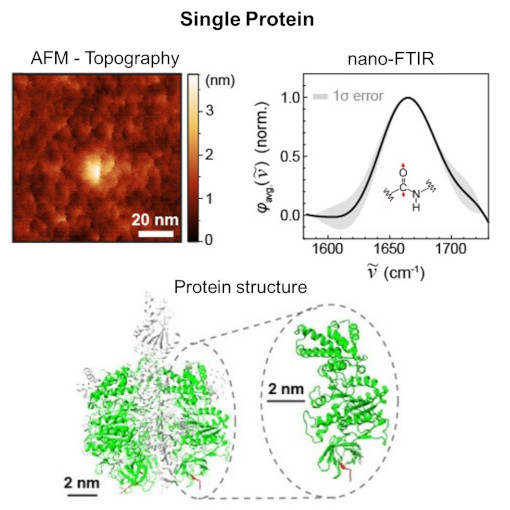
Single Protein IR Nanospectroscopy
The article from the Institute for Molecular Science discusses a breakthrough in observing single proteins using nano-FTIR, enabling the detection of infrared vibrational spectra of a single protein. This advancement allows for analyzing extremely small samples, which was previously challenging with conventional methods. The research is significant for understanding protein functions and interactions, and it opens new possibilities in nanoscale infrared spectroscopy applications across various fields. The study represents a major step in ultra-sensitive and high-resolution imaging using mid-infrared light.nano-FTIR, as demonstrated in the study, opens up diverse applications in fields like molecular biology for precise protein analysis, materials science for nanomaterial characterization, and medical diagnostics for identifying molecular markers in diseases.
This measurement was realized with the IR-neaSCOPE+s.
Further reading:
Nishida et al., Nano Lett. 2024
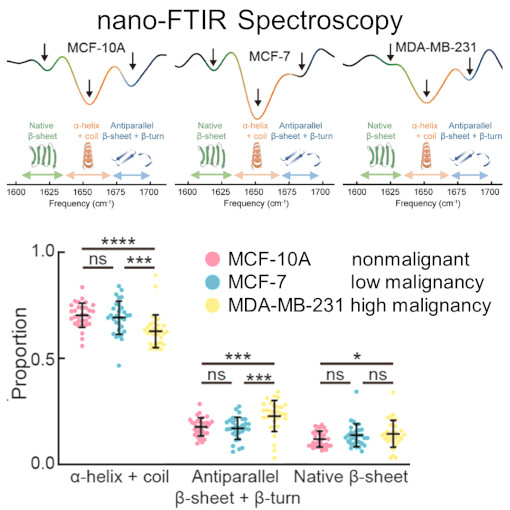
nano-Vesicle Tumor Diagnostic
Cells communicate by releasing tiny, membrane-bound vesicles, pivotal in transmitting bioactive molecules. These vesicles are not just cellular messengers; they play a crucial role in the development and spread of tumors. One intriguing aspect of these vesicles is their protein composition, which changes in correlation with the severity of malignancy. This study dives into this world of microscopic communication using nano-FTIR to examine the subtle differences in individual small extracellular vesicles related to cancer.Xue et al. discovered that as a tumor becomes more malignant, the ratio of amide I/II absorption in these vesicles increases. Ratio which corelates directly with the decrease in a-helix and random coil structures and increase of ß-sheet and ß-turn structures. The use of nano-FTIR spectroscopy is proving to be invaluable in detecting these small but critical variations. This research paves the way for a novel, noninvasive approach to understanding cancer's progression. It holds the promise of uncovering new biomarkers for cancer, potentially revolutionizing early detection methods.
This measurement was realized with the IR-neaSCOPE+s.
Further reading:
Xue et al., J. Am. Chem. 144, 20278 (2022)
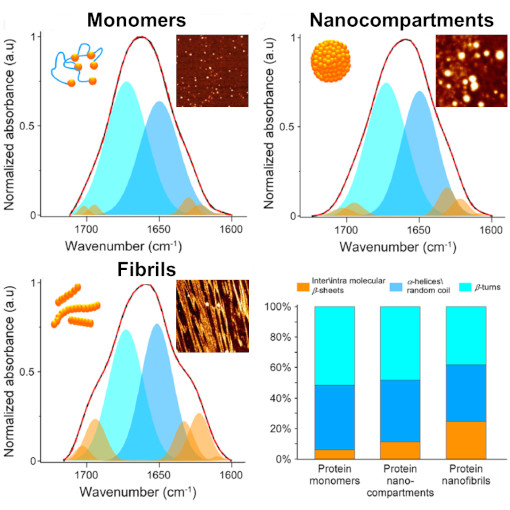
Nano-to-Micro Silk Fiber Morphing
Silk is a uniquely strong biomaterial, remarkable for its simple protein components. Despite numerous attempts, replicating silk synthetically remains a challenge. A groundbreaking discovery in silk fiber production was the formation of nanoscale compartments. These compartments facilitate a reversible transformation of silk proteins. They transition from their native structure into crystalline ß-sheets, a process that can be reversed. This reversibility is key to modifying the final mechanical properties of silk, opening doors to custom-tailored silk products. This customization is achieved by controlling the silk proteins' structural changes and their self-assembly into larger molecular formations.nano-FTIR spectroscopy has enabled researchers to closely examine protein structures at the nanometer level. This technique is especially beneficial for analyzing protein complexes and the stages of protein aggregation into fibers. It combines the morphological insights from AFM with the detailed structural information from FTIR spectroscopy. The team conducted qualitative tests with nano-FTIR spectra on different protein structures - from individual monomers to nanocompartments and fibrils - confirming the effectiveness of their method.This synergy of nano-FTIR spectroscopy and atomic force microscopy has been pivotal in deciphering the reversible transitions of silk proteins. It's a cornerstone in the journey towards developing more sophisticated and versatile silk-based materials.
This measurement was realized with the IR-neaSCOPE+s.
Further reading:
Eliaz et al., Nature Communications 13, 7856 (2022)
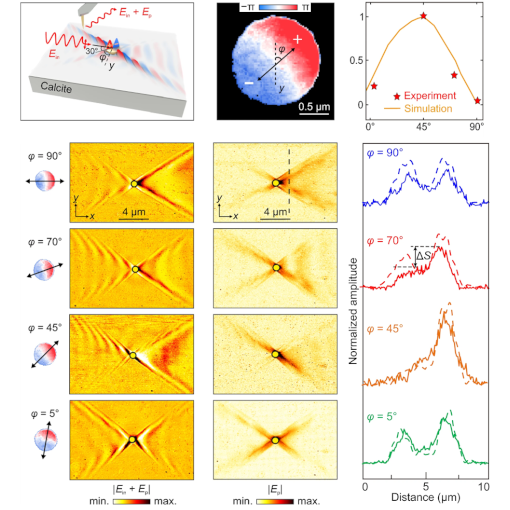
Polaritons Defy Symmetry
Nanoscale polaritons are crucial for nanophotonic devices. Hyperbolic polaritons (HPs) in high-symmetry crystals often lack directionality. In a recent eLight publication, scientists led by Profs. Zhang, Li, and Dai introduced a technique for anisotropic HP excitation and propagation. They discovered hyperbolic shear polaritons in low-symmetry crystals with enhanced directional propagation. This approach allows control of HPs' mirror symmetry without needing low crystalline symmetry. It enables tunable asymmetric polariton propagation, expanding possibilities for nanoscale light control and reconfigurable polaritonic devices.Introduced method breaks mirror symmetry in crystal polaritons, enabling control of asymmetry in HP responses. Offers nanoscale light manipulation and potential applications in nanoimaging, photonics, and quantum physics.
This measurement was realized with the IR-neaSCOPE+s.
Further reading:
Hu et al, eLight 3, 14 (2023)
SciTechDaily Article
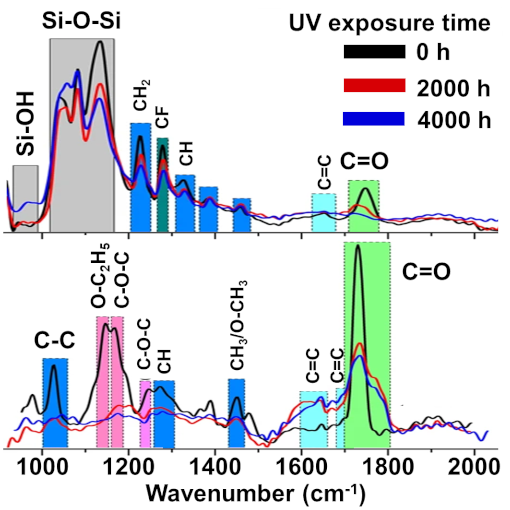
Coating Protects Ancient Pottery
Neolithic Cucuteni ceramic pottery is a valuable artifact that requires proper protection to ensure its preservation for future generations. In this study, polymer nanostructured material is used as protective coatings for the conservation of such ancient artefacts against UV ageing. In the context of comparative evaluation of the protective efficiency, this article reports the use of a functional coating that operates via specific photochemical transformations at the coating-air interface as a UV resistant protection coating for cultural heritage artefacts. An important finding was related to the decrease of the carbonyl band from 1739 cm-1 and to the appearance of other two additional bands located at 1718 (saturated aliphatic ketone) and 1712 cm-1 (carboxylic acid dimer). In addition, the loss of ester groups may be considered the main degradation process, as illustrated by the decrease of the intensity and area of the 1739 cm-1 main carbonyl stretching band.
This study reports the first investigation of the photodegradation behaviour of protective coatings through nano-FTIR technique.
This measurement was realized with the IR-neaSCOPE+s.
Further reading:
Oancea et al., Materials Degradation 7, 21 (2023)
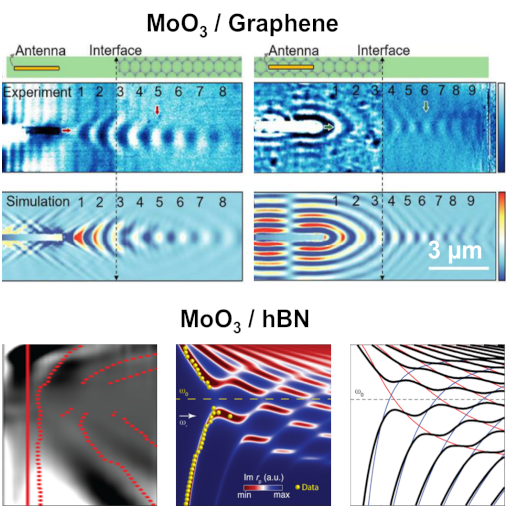
Nanoscale Negative Refraction
Refraction is a familiar effect in which a light beam alters direction as it propagates from one medium to another. Negative refraction is a nonintuitive but well-established effect in which the light beam is bent in the “wrong” direction. Two groups now independently demonstrate negative refraction at the interface of two-dimensional van der Waal materials. Hu et al. used molybdenum trioxide with a graphene MoO3 / Graphene overlayer to show that in-plane negative refraction of mid-infrared (mid-IR) polaritons occurs at the interface and is gate tunable. Sternbach et al. used molybdenum trioxide/hexagonal boron nitride MoO3 / hBN bicrystals to show that negative refraction of mid-IR polaritons occurs for propagation normal to the interface.
Polaritonic negative refraction in the mid-IR provides opportunities for optical and thermal applications such as IR super-resolution imaging, nanoscale thermal manipulation, and chemical sensing devices with enhanced sensitivity.
This measurement was realized with the IR-neaSCOPE+s.
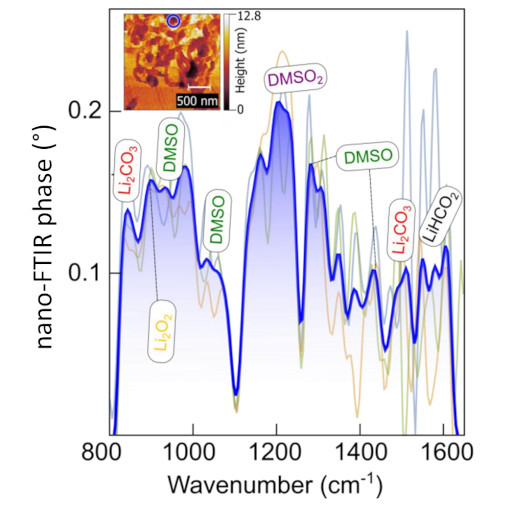
Non-Aqueous Lithium–Air Cells
Metal–air batteries, such as Li–air, may be the key for large-scale energy storage as they have the highest energy density among all electrochemical devices. However, these devices suffer from irreversible side reactions leading to battery failure, especially when ambient air is used as the O2 source. This study uses nano-FTIR to track the chemical composition changes at the nanoscale of electrode surface during cell discharge. The results obtained here open an instructive operando chemical analysis of the Li–Air battery development. The authors observed a high sensitivity to humidity and CO2 in atmospheric conditions, and that the interaction between DMSO and carbon nanotubes (CNT) generates formate species. From 140 s of operation, the DMSO presented a low decomposition rate that remained the same until the end of the discharge.
nano-FTIR is an important tool to study complex discharge processes typically found in conversion batteries, as the case studied here for Lithium–Air.
This measurement was realized with the IR-neaSCOPE+s.
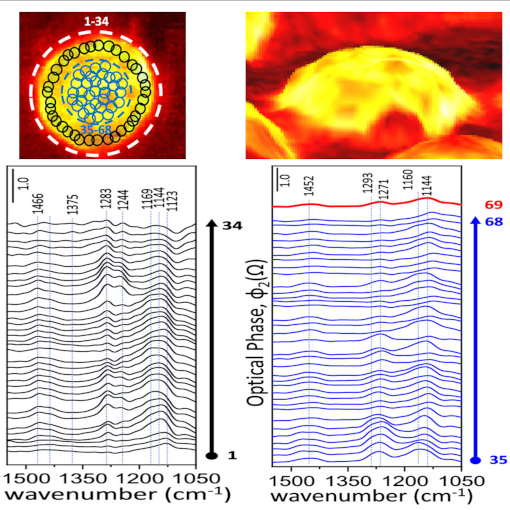
Molecular Identity of Catalytic Agent
Unambiguous identification of catalytic poisoning species requires experimental methods simultaneously delivering accurate information regarding adsorption sites and adsorption geometries of adsorbates with nanometer-scale spatial resolution, as well as their detailed chemical structure and surface functional groups. However, to date, it has not been possible to study catalytic sulfur poisoning of metal/metal-oxide interfaces at the nanometer scale without sacrificing chemical identity. In this study, nano-FTIR & s-SNOM identify the chemical nature, adsorption sites, and adsorption geometries of sulfur-based catalytic poisons on a Pd(nanodisk)/Al2O3 (thin-film) planar model catalyst surface at the nanometer scale. In addition, this study reveals striking variations between sulfate species from one nanoparticle to another and even vast alterations of sulfur poisoning on a single Pd nanoparticle.
s-SNOM & nano-FTIR provide critical molecular-level insights crucial for the development of high-performance heterogeneous catalysts with extended lifetimes.
This measurement was realized with the IR-neaSCOPE+s.
Further reading:
Say et al., JACS April 29 (2022)
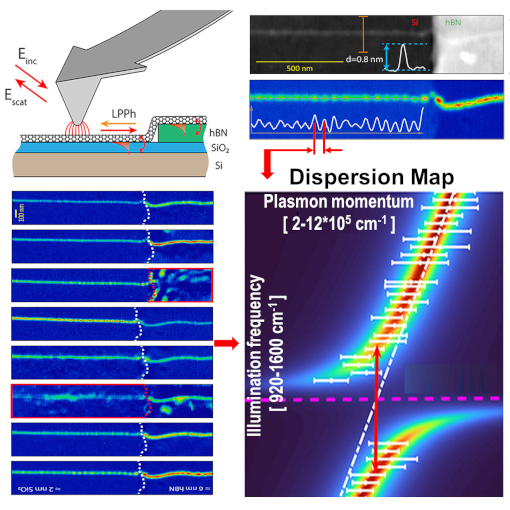
Luttinger-liquid Plasmons
1D Luttinger-liquid plasmons formed inside carbon nanotubes (CNTs) are long-lived excitations with extreme electromagnetic field confinement. In the past, s-SNOM amplitude studies were limited to semiconducting CNTs which require additional doping. This s-SNOM phase study, allows investigation of metallic carbon nanotubes as they support strong tip-launched Luttinger-liquid plasmons at ambient conditions. The Authors extracted the dispersion relation of the hybrid Luttinger-liquid plasmon–phonon polaritons. The dispersion shows pronounced mode splitting, and an ultrastrong coupling regime with phonons of both investigated substrates, i.e., native silica and hBN. Such strong coupling of quasiparticles allows now applications like induced transparency, polariton lasing, changing of the rate of chemical reactions, or enhanced sensitivity in infrared and Raman spectroscopy
s-SNOM studies of Luttinger-liquid plasmons is an essential application to develop novel low-loss plasmonic circuits for the sub-wavelength manipulation of light.
This measurement was realized with the IR-neaSCOPE+s.
Further reading:
Németh et al., Nano Lett. 22, 3495 (2022)
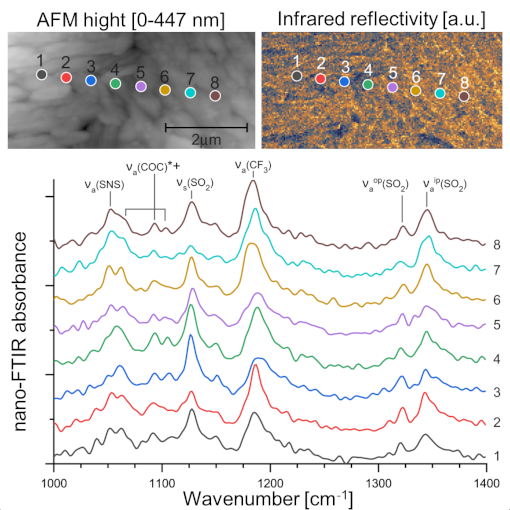
Solid-State Battery
Solid-state batteries possess the potential to significantly impact energy storage industries by enabling diverse benefits, such as increased safety and energy density. However, challenges persist with physicochemical properties and processes at electrode/electrolyte interfaces. Thus, there is great need to characterize such interfaces in situ and unveil scientific understanding that catalyzes engineering solutions. In this study, the authors conduct multiscale in situ microscopies (optical, atomic force, and infrared near-field) and nano-FTIR of intact and electrochemically operational graphene/solid polymer electrolyte interfaces. They find nanoscale structural and chemical heterogeneities intrinsic to the solid polymer electrolyte initiate a cascade of additional interfacial nanoscale heterogeneities during Li plating and stripping; including Li-ion conductivity, electrolyte decomposition, and interphase formation.
nano-FTIR applies to buried interfaces and interphases in their native environment and readily adaptable to a number of other electrochemical systems and battery chemistries.
This measurement was realized with the IR-neaSCOPE+s.
Further reading:
He et al., Nature Communications 13, 1398 (2022)
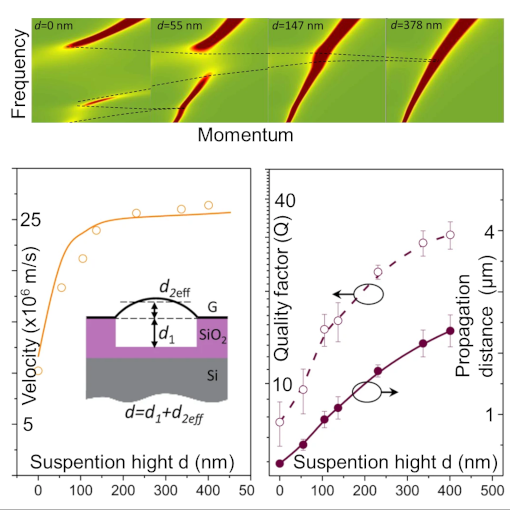
Plasmon in Suspended Graphene
Plasmons in 2D graphene have been invariably studied in supported samples so far. The substrate provides stability for graphene but often causes undesired interactions (such as dielectric losses, phonon hybridization, and impurity scattering) that compromise the quality and limit the intrinsic flexibility of graphene plasmons. This s-SNOM study demonstrate the visualization of plasmons in suspended graphene and introduces the graphene suspension height as an effective plasmonic tuning knob that enables in situ change of the dielectric environment and substantially modulates the plasmon wavelength, propagation length, and group velocity. Such active control of micrometer plasmon propagation facilitates near-unity-order modulation of nanoscale energy flow that serves as a plasmonic switch with an on-off ratio above 14.
The suspended graphene plasmons possess long propagation length, high tunability, and controllable energy transmission simultaneously, opening up broad horizons for application in nano-photonic devices.
This measurement was realized with the IR-neaSCOPE+s.
Further reading:
Hu et al., Nature Communications 13, 1465 (2022)
Organic Semiconductors
Semiconductors based on organic polymers have several advantages over their conventional, mostly silicon-based cousins. They are simpler and cheaper to manufacture, and can be produced in the form of thin, flexible layers, which allows them to be attached to diverse substrates and surfaces. Their electrical conductivity and energy efficiency are a function of the properties of the materials of which they are made. This degree of molecular order affects the mobility and transport of the charge carriers within them. Up until now, it has been very difficult to access these structures experimentally. s-SNOM and nano-FTIR make a valuable contribution to our understanding of these layered systems and to organic electronics in general.
s-SNOM & nano-FTIR is ideally suited for monitoring and optimize growth parameters to get highly ordered organic films and thus faster devices with crucial impact in development of optoelectronic devices such as OLED technology, or organic solar cells.
This measurement was realized with the IR-neaSCOPE+s.
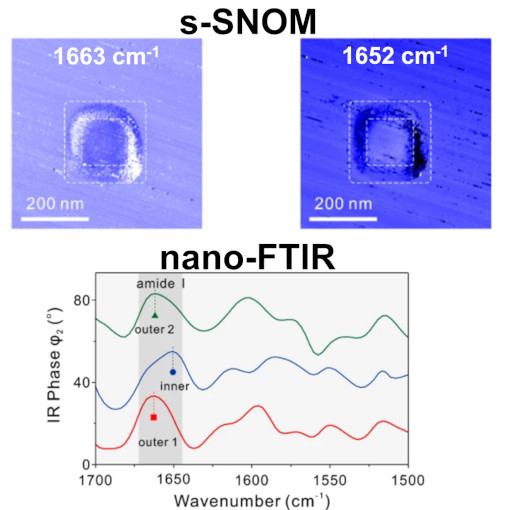
Enzymatical Biocatalytic Reactions
Biocatalytic transformations in living organisms, such as multi-enzyme catalytic cascades, proceed in different cellular membrane-compartmentalized organelles with high efficiency. Nevertheless, it remains challenging to mimic biocatalytic cascade processes of natural systems. One method to mimic natural enzymes is the use of multi-shelled metal-organic frameworks (MOFs). Such MOFs can be used as a hierarchical scaffold to spatially organize enzymes on nanoscale to enhance cascade catalytic efficiency. In this study, the authors employed s-SNOM and nano-FTIR technology, which resolves nanoscale heterogeneity of vibrational activity associated to enzymes encapsulated in multi-shelled MOFs. This work provides important insights into developing complex multi-spatial compartmental systems for multi-enzyme catalytic cascades that hold great promise in many industrial processes.
Infrared nanoscale analysis reveals molecular identity of nm-small materials. Method which can be applied in many chemical and pharmaceutical industrial processes.
This measurement was realized with the IR-neaSCOPE+s.
Further reading:
Man et al., Nature Communications 13, 305 (2022)
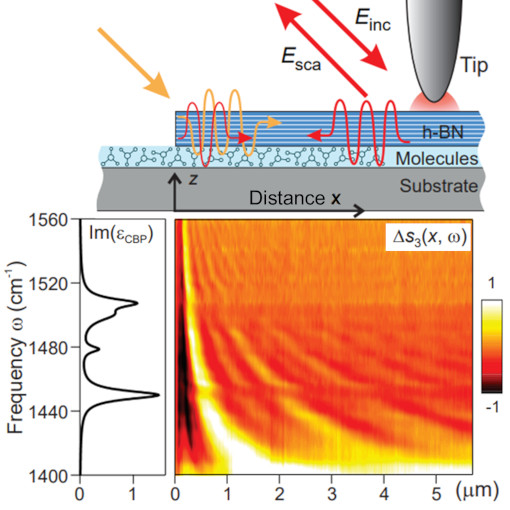
Phonon Polaritons & Organic Molecules
Light plays an essential role in modern science and technology, with applications ranging from fast optical communication to medical diagnosis and laser surgery. In many of these applications, the interaction of light with matter is of fundamental importance. The images obtained in this work reveal that the interaction between infrared light and molecular vibrations can be so strong that eventually the material properties are modified, such as conductivity and chemical reactivity. This effect, called vibrational strong coupling, could be used in the future for development of ultrasensitive spectroscopy devices or to study quantum aspects of strong vibrational coupling that have been not accessible so far.
Infrared s-SNOM imaging reveals vibrational strong coupling between propagating phonon polaritons and small organic molecules. A phenomenon with high potential to control fundamental physical and chemical material properties.
This measurement was realized with the IR-neaSCOPE+s.

Secondary Structure of Single Proteins
The secondary structure of a proteins is highly relevant in the pathogenous mechanism leading to Alzheimer, Parkinson, and other neuro-degenerative diseases. Although a variety of methods have been developed to study the protein chemistry and structure, recognizing and mapping the secondary structure on the nanometer scale, or even with single protein sensitivity, is still a major challenge. nano-FTIR technology is used in this study to enabled nanoscale chemical imaging and probing of protein’s secondary structure with enormous sensitivity. In short, a sharp metalized tip is illuminated with a broadband infrared laser beam, and the backscattered light is analyzed with a specially designed Fourier transform spectrometer.
nano-FTIR probes the infrared spectroscopy and resolves the secondary structure of proteins complexes with diameter of 12 nm, 6 nm protein monolayer and even of 3 nm thin fibrils.
This measurement was realized with the IR-neaSCOPE+s.
Further reading:
Amenabar et al., Nature Communications 4, 2890 (2013)


